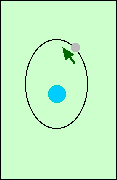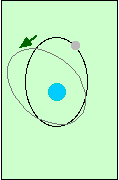Fourier Analysis of Ocean Tides I
5. The lunar tide
The lunar tide is more complicated to study because the motion of the Moon around the Earth is considerably more complicated than that of the Earth around the Sun.
|

|

|

|
|
The moon travels in an orbit
ot significant eccentricity.
Speed: s = 0.55o/hour |
The axis of that ellipse precesses
in the plane of the moon's orbit.
Speed: p = 0.0046o/hour |
That plane precesses with respect
to the plane of the Earth's orbit.
Speed: N = -0.0022o/hour |
For example, the change in the moon's longitude per hour is T+h-s = 14.49 degrees/hour.
Nevertheless, when the vertical component of the lunar tide-producing force is computed as a function of time, geometric and trigonometric analysis like that performed on the solar tide-producing force leads to the analogous result:
| The vertical component of the lunar tide-producing force at a point P is, as a function of time, a finite linear combination of cosines and sines, whose speeds are certain integral linear combinations of T, h, s, p and N. |
The tidal record at any port is not periodic, even when transient weather-related effects are subtracted. It never repeats itself exactly. But knowing that the tide-producing force can be expressed as a linear combination of functions which are themselves periodic, with known frequencies, we can expect that the tidal record at any port will also be such a linear combination, with the same frequencies. The coefficients will depend on the port, and can be determined by Fourier analysis of the tidal record. Once the coefficients are known, the tides can be predicted. This is the method of ``harmonic analysis of tides."
For example, here are the speeds of some important "constituents" of the ocean tide. These are the ten frequencies that occur with the highest coefficients in the analysis of the tide at Bridgeport, Connecticut.
| symbol |
speed |
symbol |
speed |
| M2 |
2T-2s+2h |
N2 |
2T-3s+2h+p |
| S2 |
2T |
K1 |
T+h |
| L2 |
2T-s+2h-p |
O1 |
T-2s+h |
| Sa |
h |
nu2 |
2T-3s+4h-p |
| K2 |
2T-2h |
Mm |
s-p |
Welcome to the
Feature Column!
These web essays are designed for those who have already discovered the joys of mathematics as well as for those who may be uncomfortable with mathematics.
Read more . . .
Feature Column at a glance





